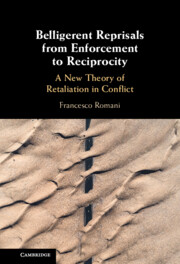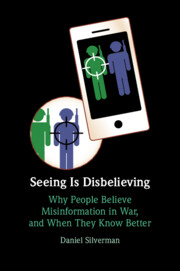209 results
Case note: The International Court of Justice’s 2022 reparations judgment in DRC v. Uganda
-
- Journal:
- International Review of the Red Cross , First View
- Published online by Cambridge University Press:
- 28 March 2025, pp. 1-16
-
- Article
-
- You have access
- Open access
- HTML
- Export citation
Gender Equality and Armed Conflict: A Critique of Total Fertility Rate as an Indicator
-
- Journal:
- Politics & Gender , First View
- Published online by Cambridge University Press:
- 26 February 2025, pp. 1-15
-
- Article
-
- You have access
- Open access
- HTML
- Export citation
Estimated baseline density of a spotted hyaena population in a post-war landscape
-
- Journal:
- Oryx , First View
- Published online by Cambridge University Press:
- 27 January 2025, pp. 1-11
-
- Article
-
- You have access
- Open access
- HTML
- Export citation

Belligerent Reprisals from Enforcement to Reciprocity
- A New Theory of Retaliation in Conflict
-
- Published online:
- 12 December 2024
- Print publication:
- 19 December 2024
1 - Defining Terrorism in International Law
-
- Book:
- International Counterterrorism Law
- Published online:
- 31 August 2024
- Print publication:
- 12 December 2024, pp 20-51
-
- Chapter
- Export citation
War exposure, daily stressors, and mental health 15 years on: implications of an ecological framework for addressing the mental health of conflict-affected populations
- Part of
-
- Journal:
- Epidemiology and Psychiatric Sciences / Volume 33 / 2024
- Published online by Cambridge University Press:
- 11 December 2024, e78
-
- Article
-
- You have access
- Open access
- HTML
- Export citation
The ICRC's approach to peace: Interview with Eva Svoboda: Director of International Law, Policy and Archives, ICRC
-
- Journal:
- International Review of the Red Cross / Volume 106 / Issue 927 / December 2024
- Published online by Cambridge University Press:
- 24 February 2025, pp. 979-988
- Print publication:
- December 2024
-
- Article
-
- You have access
- Open access
- HTML
- Export citation
The Tragedy Trap: On the Tragicized Politics of Nuclear Weapons and Armed Drones and the Making of Unaccountability
-
- Journal:
- Ethics & International Affairs / Volume 38 / Issue 2 / Summer 2024
- Published online by Cambridge University Press:
- 22 November 2024, pp. 209-231
-
- Article
-
- You have access
- Open access
- HTML
- Export citation
1 - Introduction
-
- Book:
- Seeing Is Disbelieving
- Published online:
- 31 August 2024
- Print publication:
- 21 November 2024, pp 1-17
-
- Chapter
-
- You have access
- HTML
- Export citation
Addressing missing persons arising from armed conflict as a driver of peace: Towards a research agenda
-
- Journal:
- International Review of the Red Cross / Volume 106 / Issue 927 / December 2024
- Published online by Cambridge University Press:
- 07 October 2024, pp. 1108-1131
- Print publication:
- December 2024
-
- Article
-
- You have access
- Open access
- HTML
- Export citation
Technology and the Civilianization of Warfare
-
- Journal:
- Ethics & International Affairs / Volume 38 / Issue 1 / Spring 2024
- Published online by Cambridge University Press:
- 01 October 2024, pp. 64-74
-
- Article
-
- You have access
- Open access
- HTML
- Export citation
The Cost of Atrocity: Strategic Implications of Russian Battlefield Misconduct in Ukraine
-
- Journal:
- Ethics & International Affairs / Volume 38 / Issue 1 / Spring 2024
- Published online by Cambridge University Press:
- 01 October 2024, pp. 6-16
-
- Article
-
- You have access
- Open access
- HTML
- Export citation
What militaries need to know about data protection and the right to digital privacy/private life
-
- Journal:
- International Review of the Red Cross , First View
- Published online by Cambridge University Press:
- 30 September 2024, pp. 1-17
-
- Article
-
- You have access
- Open access
- HTML
- Export citation
A US perspective on special operations and the law of armed conflict
-
- Journal:
- International Review of the Red Cross , First View
- Published online by Cambridge University Press:
- 27 September 2024, pp. 1-26
-
- Article
-
- You have access
- Open access
- HTML
- Export citation
The Effect of Russia's Invasion of Ukraine on Non-Human Animals: International Humanitarian Law Perspectives
-
- Journal:
- Israel Law Review / Volume 57 / Issue 2 / July 2024
- Published online by Cambridge University Press:
- 13 September 2024, pp. 265-287
-
- Article
-
- You have access
- Open access
- HTML
- Export citation

Seeing Is Disbelieving
- Why People Believe Misinformation in War, and When They Know Better
-
- Published online:
- 31 August 2024
- Print publication:
- 21 November 2024
How harmful information on social media impacts people affected by armed conflict: A typology of harms
-
- Journal:
- International Review of the Red Cross / Volume 106 / Issue 926 / August 2024
- Published online by Cambridge University Press:
- 18 December 2024, pp. 823-862
- Print publication:
- August 2024
-
- Article
-
- You have access
- Open access
- HTML
- Export citation
Niche small States in humanitarian diplomacy: Qatar's positionality in the protection ecosystem
-
- Journal:
- International Review of the Red Cross / Volume 106 / Issue 926 / August 2024
- Published online by Cambridge University Press:
- 18 December 2024, pp. 585-609
- Print publication:
- August 2024
-
- Article
-
- You have access
- Open access
- HTML
- Export citation
African customs and traditions and the indigenization of international humanitarian law in armed conflict
-
- Journal:
- International Review of the Red Cross / Volume 106 / Issue 926 / August 2024
- Published online by Cambridge University Press:
- 14 October 2024, pp. 639-658
- Print publication:
- August 2024
-
- Article
-
- You have access
- HTML
- Export citation
12 - War Crimes
- from Part IV - Substantive Law of International Crimes
-
- Book:
- An Introduction to International Criminal Law and Procedure
- Published online:
- 07 November 2024
- Print publication:
- 18 July 2024, pp 247-283
-
- Chapter
- Export citation

 Eva Svoboda worked with the International Committee of the Red Cross (ICRC) from 1999 to 2011 in Kashmir, Sudan, Myanmar, Iraq, East Timor, the Democratic Republic of the Congo and Algeria as Protection Coordinator, Head of Office and Head of Sub-Delegation, as well as Head of Delegation. Prior to joining the ICRC, she worked for the Swiss Development Agency and various non-governmental organizations. From 2012 to 2018 she was a Senior Research Fellow with the Humanitarian Policy Group at the Overseas Development Institute in London. Between 2016 and 2017 she worked as the Senior Expert for Detainees and the Missing at the United Nations (UN) Office of the Special Envoy for Syria.
Eva Svoboda worked with the International Committee of the Red Cross (ICRC) from 1999 to 2011 in Kashmir, Sudan, Myanmar, Iraq, East Timor, the Democratic Republic of the Congo and Algeria as Protection Coordinator, Head of Office and Head of Sub-Delegation, as well as Head of Delegation. Prior to joining the ICRC, she worked for the Swiss Development Agency and various non-governmental organizations. From 2012 to 2018 she was a Senior Research Fellow with the Humanitarian Policy Group at the Overseas Development Institute in London. Between 2016 and 2017 she worked as the Senior Expert for Detainees and the Missing at the United Nations (UN) Office of the Special Envoy for Syria.
